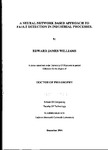A NEURAL NETWORK BASED APPROACH TO FAULT DETECTION IN INDUSTRIAL PROCESSES
| dc.contributor.author | WILLIAMS, EDWARD JAMES | |
| dc.contributor.other | School of Engineering, Computing and Mathematics | en_US |
| dc.date.accessioned | 2013-09-16T10:37:32Z | |
| dc.date.available | 2013-09-16T10:37:32Z | |
| dc.date.issued | 1994 | |
| dc.identifier | NOT AVAILABLE | en_US |
| dc.identifier.uri | http://hdl.handle.net/10026.1/1743 | |
| dc.description.abstract |
The need for automated fault detection methods has increased in line with the complexity of processing plant technology and their control systems. Fast and accurate fault detection and isolation (FDI) is essential if a controller is to be effective in a supervisory role. This thesis is concerned with developing an FDI system based upon artificial neural network techniques. The artificial neural network (ANN) is a mechanism based upon the concepts of information processing within the brain, and consequently has the ability to self adjust, or learn about a given problem domain. It can thus be utilised in currently favoured model-based FDI systems with the advantage that it can learn process dynamics by being presented examples of process input-output pairs without the need for traditional mathematically complex models. Similarly, ANNs can be taught to classify characteristics in the residual (or plant-model difference) signal without the necessity of constructing the types of filter used in more classical solutions. Initially, a class of feedforward neural network called the multilayer perceptron (MLP) is used to model mathematically simulated linear and nonlinear plants in order to demonstrate their abilities in this field, as well as investigating the consequence of parameter variation on model effectiveness and how the model can be utilised in a model-based FDI system. A principle aim of this research is to demonstrate the ability of the system to work online and in real-time on genuine industrial processes, and the plant nominated as a test bed - the Unilever Automated Freezer (UAF) - is introduced. The UAF, being a time-varying system, requires a novel system identification approach which has resulted in a number of cascaded MLPs to model the various stages in the phased startup of the process. In order to reduce model mismatch to a minimum, it was necessary to develop an effective switching mechanism between one MLP in the cascade and the next. Attempts using a rule-based switching mechanism, a simple MLP switch and an error based switching mechanism were made, before a solution incorporating a genetic algorithm and an MLP network was developed which had the capability of learning the optimum switching points. After the successful development of the model, a series of MLPs were trained to recognise the characteristics of a number of faults within the residual signals. Problems involving false alarms between certain faults were reduced by the introduction of templates - or information pertaining to when a particular fault was most evident in the residuals. The final solution consisting of an MLP Cascade model and fault isolation MLPs is essentially generic for this class of time-varying system, and the results achieved on the UAF were far superior to those of the currently used FDI system without the need for any extra sensory information. The MLP Cascade and associated switching device together with the development of an online real-time FDI system for a time-varying piece of industrial machinery, are deemed to be original contributions to knowledge. | en_US |
| dc.description.sponsorship | Unilever Research Colworth Laboratory | en_US |
| dc.language.iso | en | en_US |
| dc.publisher | University of Plymouth | en_US |
| dc.title | A NEURAL NETWORK BASED APPROACH TO FAULT DETECTION IN INDUSTRIAL PROCESSES | en_US |
| dc.type | Thesis | |
| plymouth.version | Full version | en_US |
| dc.identifier.doi | http://dx.doi.org/10.24382/4173 | |
| dc.identifier.doi | http://dx.doi.org/10.24382/4173 |
Files in this item
This item appears in the following Collection(s)
-
01 Research Theses Main Collection
Research Theses Main


